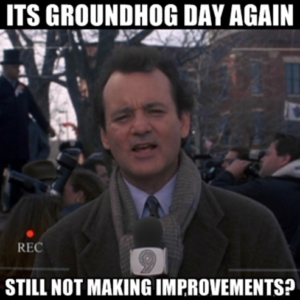 If you were to look back at how your organization has handled certain initiatives over the years it might look like they are in a repeating cycle of trial and error.
If you were to look back at how your organization has handled certain initiatives over the years it might look like they are in a repeating cycle of trial and error.
For those who may not have seen the movie “Groundhog Day” it is a story about a weatherman named Phil Connors (played by Bill Murray) who wakes up every morning and it is February 2nd Groundhog Day. No matter what he does throughout the day he will wake up the next morning on February 2nd and continue the same loop every day.
Does this sound familiar?
There are times where we might find ourselves in this same type of endless loop where no matter what we do, we end up right where we started with no measurable improvement. This in turn messes with people in the organization in a way that almost detracts from being able to improve in the first place
So, what do you do?
The first step is to think about what your end state is going to look like. Remember that simple is best and we can always build on that. Even if the goal seems really big we may need to break it up into consumable and achievable goals. Being agile is key here.
Next, stop and really think about what roadblocks are preventing your team from getting your goals accomplished. When you run through this exercise don’t focus only on technical constraints. This may be tough to do especially when this is what you are used to. You also need to consider how people and culture come into play. For example, if your roadblocks are related to someone in leadership who is challenging this activity then capture that constraint. Understand what is preventing them for seeing things in a way which helps moves us forward.
Lets look at an example,
Suppose that we are having difficulty getting problem management off the ground. Our technical operations and service delivery teams may fully appreciate the many benefits of this practice but for some reason it just isn’t happening the way we had envisioned. This is a perfect time to look at the full picture to see what is impacting this from taking flight.
What we hear
“Our team doesn’t have the people to do this work”
You have likely heard this excuse before. Instead of using this as a crutch, let’s focus on how we can get around this by re-marketing the way we are looking at this practice from a resource perspective. Many organizations will say that they simply don’t have the bandwidth for other practices at the moment. Perhaps we need to find a way to ensure that the teams that are impacted by the incidents have the tools to investigate and manage the issues in a proactive way. We may not have a ‘problem manager’ but by managing the work load we can reduce the waste work generated by incidents. People might just see this as ‘more work to do’ but if this added effort is marketed in a way which shows long term work reductions than we can move the needle on this.
“We don’t get traction with the problems that we work”
If you are hearing this you need to make sure you are working on the right things. Working on an issue which might be the result of a memory leak might be a suitable problem by the books, but we need to start thinking outside of that thought pattern if we are going to gain some momentum on how problem is perceived. How is resolving this problem going to help achieve your business objectives? How does this move us in a direction of automating redundant work? Instead we might want to take on a problem that impacts tasks which would be better if they were automated (password resets) or even training issues that could be managed by a knowledge article. While these might not sound like a traditional ‘problem management’ activity, they do achieve what problem management is setting out to do.
‘No one understands what problem management is’
I have news for you, they don’t actually care. However they do care about what a solid problem resolution can produce – results. Learn to celebrate your successes. Communicate when you are able to achieve wins by making progress. Even if they are small to you they can build up to something substantial.
In the movie Groundhog Day the main character, Phil is finally able to escape this loop by connecting with the people on a personal level in the town of Punxsutawney where he exists day after day. Through this he understands their culture and environment. He actively listens to what challenges they have and helps them wherever he can. The takeaway here is to do the same thing from a support perspective and understand what you can do to get out of your own loop and make a difference.
 If you were to look back at how your organization has handled certain initiatives over the years it might look like they are in a repeating cycle of trial and error.
If you were to look back at how your organization has handled certain initiatives over the years it might look like they are in a repeating cycle of trial and error.